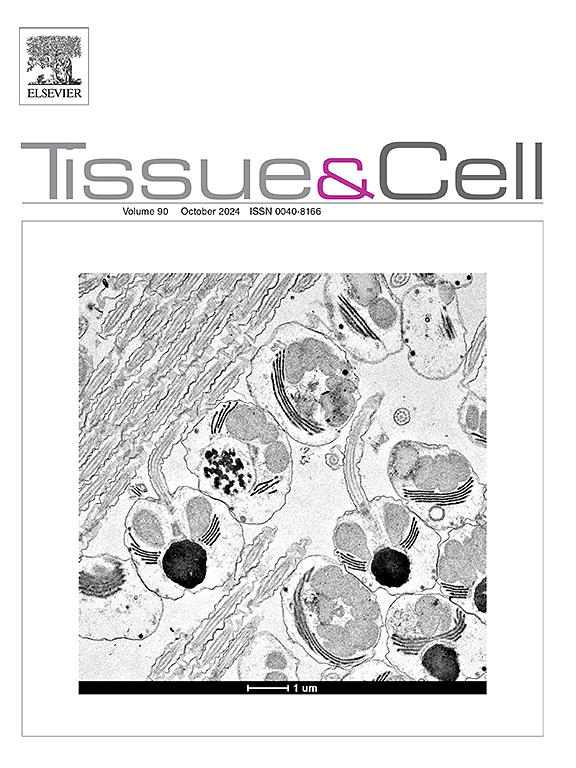Proteins extracted from placenta regulate osteogenic differentiation of human mesenchymal stem cells
IF 2.7
4区 生物学
Q1 ANATOMY & MORPHOLOGY
引用次数: 0
Abstract
Placenta is a medical waste, but the human placenta-derived proteins (hPDPs) have highly significant application value. The precise mechanism of injectable hPDPs gel on bone regeneration has been scarcely studied. In this study, a succinct methodology was employed to extract all proteins in the placenta. Proteomic analysis revealed that key gene ontology (GO) terms, signaling pathways, and osteogenic stimulators in PDPs, such as THY1, GDF15, SPARC, GPNMB, PARK7, EFEMP1, and LRP. In order to provide evidence supporting the ability of injectable hPDPs to promote osteogenesis and osteogenic differentiation (OD), the in vitro experiments utilizing human mesenchymal stem cells (hMSCs) and in vivo heterotopic osteogenesis animal models were conducted to assess the bone-forming ability of hPDPs. Results demonstrated that hPDPs accelerated OD of hMSCs and enhanced osteogenesis. Proteomic data, qPCR, immunofluorescence (IF) staining, RNA-sequencing data, KEGG, and GO enrichment analysis were utilized to elucidate the mechanisms underlying hPDP-induced OD. The findings indicated that the PDPs could promote OD through the activation of osteogenic stimulators and multiple signaling pathways, especially the BMP2/TGF-β signaling pathway and the iron metabolism pathway. This research elucidated the function and mechanism of PDPs in OD, providing valuable insights into their potential clinical applications. The findings suggest a novel strategy for utilizing medical waste or their stimulators as biocompatible materials for bone tissue engineering applications.
胎盘蛋白对人间充质干细胞成骨分化的调控作用
胎盘是一种医疗废物,但人胎盘源性蛋白(hpdp)具有很高的应用价值。可注射hpdp凝胶对骨再生的确切作用机制研究甚少。在本研究中,采用一种简洁的方法提取胎盘中的所有蛋白质。蛋白质组学分析揭示了pdp中的关键基因本体(GO)术语、信号通路和成骨刺激物,如THY1、GDF15、SPARC、GPNMB、PARK7、EFEMP1和LRP。为了提供可注射hpdp促进成骨和成骨分化(OD)能力的证据,我们利用人间充质干细胞(hMSCs)和体内异位成骨动物模型进行了体外实验,以评估hpdp的成骨能力。结果表明,hpdp加速了hMSCs的OD,促进了成骨。利用蛋白质组学数据、qPCR、免疫荧光(IF)染色、rna测序数据、KEGG和氧化石墨烯富集分析来阐明hpdp诱导OD的机制。结果表明,pdp可通过激活成骨刺激因子和多种信号通路,特别是BMP2/TGF-β信号通路和铁代谢途径促进OD。本研究阐明了pdp在OD中的作用和机制,为其潜在的临床应用提供了有价值的见解。研究结果提出了一种利用医疗废物或其刺激物作为骨组织工程应用的生物相容性材料的新策略。
本文章由计算机程序翻译,如有差异,请以英文原文为准。
求助全文
约1分钟内获得全文
求助全文
来源期刊

Tissue & cell
医学-解剖学与形态学
CiteScore
3.90
自引率
0.00%
发文量
234
期刊介绍:
Tissue and Cell is devoted to original research on the organization of cells, subcellular and extracellular components at all levels, including the grouping and interrelations of cells in tissues and organs. The journal encourages submission of ultrastructural studies that provide novel insights into structure, function and physiology of cells and tissues, in health and disease. Bioengineering and stem cells studies focused on the description of morphological and/or histological data are also welcomed.
Studies investigating the effect of compounds and/or substances on structure of cells and tissues are generally outside the scope of this journal. For consideration, studies should contain a clear rationale on the use of (a) given substance(s), have a compelling morphological and structural focus and present novel incremental findings from previous literature.
 求助内容:
求助内容: 应助结果提醒方式:
应助结果提醒方式:


